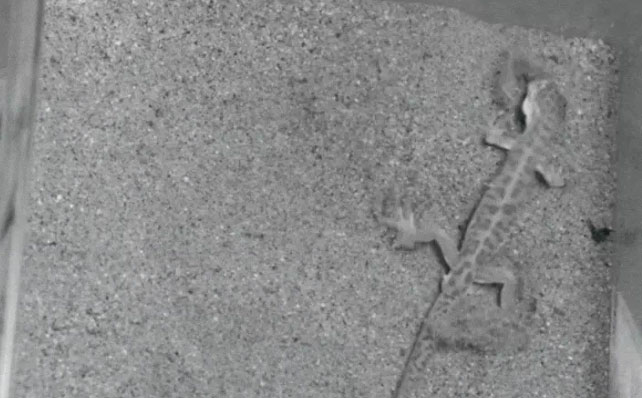This violent behavior helps the Western banded gecko protect itself from scorpion venom.
A new study reveals that usually calm and gentle geckos turn aggressive, almost “berserk,” when trying to subdue their meal, which is… a scorpion.
When a Western banded gecko (scientific name: Coleonyx variegatus) bites a scorpion, it repeatedly shakes its head from side to side, slamming the scorpion to the ground over and over again. The lead author, Malachi Whitford, who conducted this research as part of his PhD program in ecology at San Diego State University (SDSU), stated that geckos are “the least scary animals you will ever meet, but once they see a scorpion, they seem to switch to ‘berserker mode’“.
According to the study, this violent behavior may help geckos protect themselves from scorpion venom.

Geckos tend to exhibit extremely aggressive “berserker” behavior when encountering scorpions.
Whitford mentioned that animals such as roadrunners, crocodiles, and some carnivorous mammals have the ability to incapacitate their prey by shaking their bodies.
The Western banded gecko lives in the arid regions of the Southwestern United States and typically measures about 10 to 15 cm in length. This reptile primarily feeds on insects but occasionally consumes desert hairy scorpions (Sumbleurus mesaensis).
Co-author of the study and biology professor at SDSU, Rulon Clark, first observed the geckos eating scorpions in the 1990s when he was a research assistant working in a desert near Yuma, Arizona. When researchers decided to investigate further, they clearly found that geckos tend to exhibit “berserker mode” extremely aggressively when encountering scorpions.
After shaking the scorpion vigorously, the gecko quickly consumes it, Whitford noted. “The entire process is over in just a few seconds”.
Scientists filmed geckos catching scorpions and other prey at a speed of 1,200 frames per second. They conducted 21 trials, with 9 geckos being fed scorpions and 10 trials involving 8 geckos eating other insect prey. Using digital tracking technology, scientists mapped the head movements of the geckos frame by frame, measuring variables such as velocity and acceleration as the geckos slammed the scorpions back and forth over a dozen times in just a few seconds.
The research shows that geckos rotate their heads and bodies back and forth rhythmically to slam the scorpion to the ground. This action may help geckos safely consume scorpions. One possibility is that the shaking renders the scorpion immobile; however, only about 62% of scorpions became immobilized after being shaken around.
It is also unclear whether geckos develop resistance to scorpion venom. According to the study, 90% of the geckos fed scorpions were stung during the encounter, but the head-shaking action may reduce the severity of the sting or prevent the scorpion from delivering its full venom. All the shaking and slamming may also be an effort to break the scorpion’s stinger.
Researchers stated: “Given the speed and violence of the prey capture process, we believe that geckos slam scorpions to cause massive injury and immobilize them, or potentially break the stinger and render the scorpion harmless.”
“From our videos, it is clear that the geckos are slamming the scorpions hard into the ground. However, we have not yet been able to describe the force applied to the scorpions,” Whitford explained. “Ideally, the next step will be to study this behavior using 3D filming technology.”


















































